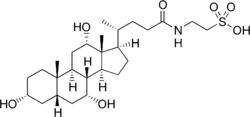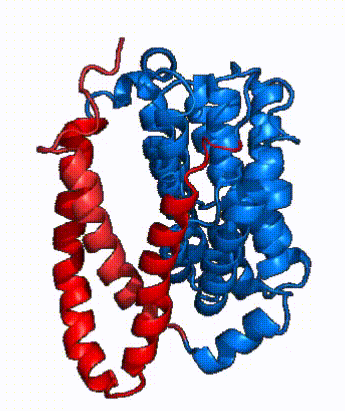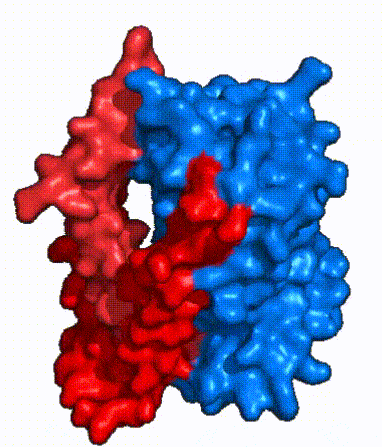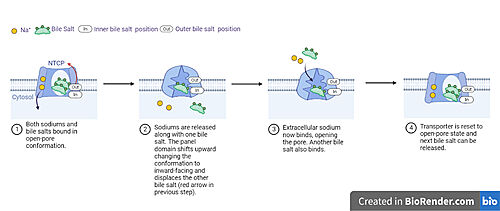Sandbox Reserved 1793
From Proteopedia
(Difference between revisions)
| Line 15: | Line 15: | ||
=== Binding Sites === | === Binding Sites === | ||
==== Sodium ==== | ==== Sodium ==== | ||
| - | NTCP, | + | NTCP, like other SLC10 family members, have <scene name='95/952721/Sodium_binding/5'>two sodium binding</scene>. Many polar and negatively charged residues (68, 105, 106, 119, 123, 257, 261) form ion-dipole or dipole-dipole interactions with the sodium ions in these sites with a high level of conservation, suggesting odium binding is coupled to bile salt transport. <Ref name = "Goutam"> Mutations in the X-motif near sodium binding sites inhibit bile salt transport function, suggesting that sodium allows is required for salt binding. |
| - | <Ref name = "Goutam"> Goutam, K., Ielasi, F.S., Pardon, E. et al. Structural basis of sodium-dependent bile salt uptake into the liver. Nature 606, 1015–1020 (2022). [https://doi.org/10.1038/s41586-022-04723-z DOI: 10.1038/s41586-022-04723-z]. </Ref> | + | <Ref name = "Goutam"> Goutam, K., Ielasi, F.S., Pardon, E. et al. Structural basis of sodium-dependent bile salt uptake into the liver. Nature 606, 1015–1020 (2022). [https://doi.org/10.1038/s41586-022-04723-z DOI: 10.1038/s41586-022-04723-z]. </Ref> Thermodynamically favorable sodium transport facilitates changes in NTCP from open-pore to closed pore states, moving bile salts against their concentration gradient. The inward-facing state is favored in the absence of sodium ions, while open-pore state is favored in the presence of sodium ions. <Ref name = "Goutam"> This also allows for sodium concentrations to regulate uptake of taurocholates. When intracellular sodium levels are higher, open-pore state is favored allowing for the diffusion of taurocholates. However, when extracellular sodium levels are high, inward-facing state is favored preventing diffusion of taurocholates. <ref name="Goutam"/> |
==== Bile Salt ==== | ==== Bile Salt ==== | ||
Revision as of 16:21, 14 April 2023
Sodium Bile Salt Co-Transporting Protein
| |||||||||||
References
- ↑ Stieger B. The role of the sodium-taurocholate cotransporting polypeptide (NTCP) and of the bile salt export pump (BSEP) in physiology and pathophysiology of bile formation. Handb Exp Pharmacol. 2011;(201):205-59. doi: 10.1007/978-3-642-14541-4_5. PMID: 21103971. DOI: DOI: 10.1007/978-3-642-14541-4_5.
- ↑ Geyer, J., Wilke, T. & Petzinger, E. The solute carrier family SLC10: more than a family of bile acid transporters regarding function and phylogenetic relationships. Naunyn Schmied Arch Pharmacol 372, 413–431 (2006). https://doi.org/10.1007/s00210-006-0043-8
- ↑ 3.0 3.1 3.2 Park, JH., Iwamoto, M., Yun, JH. et al. Structural insights into the HBV receptor and bile acid transporter NTCP. Nature 606, 1027–1031 (2022). https://doi.org/10.1038/s41586-022-04857-0.
- ↑ 4.0 4.1 Mutations in the X-motif near sodium binding sites inhibit bile salt transport function, suggesting that sodium allows is required for salt binding. <ref> Goutam, K., Ielasi, F.S., Pardon, E. et al. Structural basis of sodium-dependent bile salt uptake into the liver. Nature 606, 1015–1020 (2022). [https://doi.org/10.1038/s41586-022-04723-z DOI: 10.1038/s41586-022-04723-z]. </li> <li id="cite_note-Liu-4">↑ <sup>[[#cite_ref-Liu_4-0|5.0]]</sup> <sup>[[#cite_ref-Liu_4-1|5.1]]</sup> <sup>[[#cite_ref-Liu_4-2|5.2]]</sup> Liu, H., Irobalieva, R.N., Bang-Sørensen, R. et al. Structure of human NTCP reveals the basis of recognition and sodium-driven transport of bile salts into the liver. Cell Res 32, 773–776 (2022). https://doi.org/10.1038/s41422-022-00680-4 </li> <li id="cite_note-Latorraca-5">[[#cite_ref-Latorraca_5-0|↑]] Latorraca, N. R.; Fastman, N. M.; Venkatakrishnan, A. J.; Frommer, W. B.; Dror, R. O.; Feng, L. Mechanism of Substrate Translocation in an Alternating Access Transporter. Cell 2017, 169 (1), 96–107. </li> <li id="cite_note-Asami-6">↑ <sup>[[#cite_ref-Asami_6-0|7.0]]</sup> <sup>[[#cite_ref-Asami_6-1|7.1]]</sup> <sup>[[#cite_ref-Asami_6-2|7.2]]</sup> <sup>[[#cite_ref-Asami_6-3|7.3]]</sup> Asami, J., Kimura, K.T., Fujita-Fujiharu, Y. et al. Structure of the bile acid transporter and HBV receptor NTCP. Nature 606, 1021–1026 (2022). https://doi.org/10.1038/s41586-022-04845-4 </li> <li id="cite_note-Grove-7">[[#cite_ref-Grove_7-0|↑]] Grove, J.; Marsh, M. The Cell Biology of Receptor-Mediated Virus Entry. Journal of Cell Biology 2011, 195 (7), 1071–1082. </li> <li id="cite_note-Herrscher-8">↑ <sup>[[#cite_ref-Herrscher_8-0|9.0]]</sup> <sup>[[#cite_ref-Herrscher_8-1|9.1]]</sup> Herrscher C, Roingeard P, Blanchard E. Hepatitis B Virus Entry into Cells. Cells. 2020 Jun 18;9(6):1486. doi: 10.3390/cells9061486. PMID: 32570893; PMCID: PMC7349259. </li></ol></ref>




